Key Takeaways
- A focal point helps guide the eye and simplifies design choices.
- Color can highlight favorite features, furniture, or architectural details.
- Contrast is key. Look for ways to create clear separation between focal areas and the rest of the room.
- Subtle color accents can be just as powerful as bold choices.
- Good lighting keeps accent colors from appearing flat or dull.
Introduction

Do you ever stare at a room and think something is missing? Maybe you see great furniture, lovely accessories, and a nice layout. Yet it lacks a visual anchor. A striking focal point can complete the look. It captures attention and sets a theme. Color is a powerful tool for creating such focus.
People often chase the perfect paint color or arrangement for their living spaces. They blend furniture styles, decor pieces, and seasonal accents. It can feel overwhelming. A smart way to simplify is to start with one main point of interest. Then let color bring that spot to life.
This article will show you ways to make a room pop using color. You will find easy tips, out-of-the-box approaches, and plenty of examples. We will also explore products that can help, from bold wallpaper to stunning accent pillows. By the end, you will have a clear plan for using color to attract attention in any part of your home. So if you are ready for a decor upgrade, keep reading.
The Basics of Focal Points

Creating a focal point means directing the gaze. Think of it like giving your room a stage. Everything else supports that stage, but your chosen focal spot shines first. This approach makes color choices easier.
What Counts as a Focal Point?
Some rooms have natural focal points. Fireplaces, built-in shelves, or large picture windows can draw the eye. In other spaces, the focal point might be a bold sofa or a piece of art. Look for something with presence or the potential to stand out.
If you have no built-in feature, try adding one. A bright canvas or a tall mirror can do the trick. When picking a piece to highlight, imagine how the eye travels when you step through the door. That main piece should feel special.
Why Use Color to Highlight a Focal Point?
Color injects energy. It frames objects and guides where your focus goes. Contrasts between bold or light shades catch our attention in a simple way. If you have a prized painting, for instance, a contrasting color behind it will help it pop. This method also keeps your design from getting lost in a sea of neutrals.
Common Mistakes to Avoid
- Too many focal points: One or two highlights is enough. Otherwise, the eye becomes confused.
- Ignoring scale: The item you want to highlight should fit the space. A tiny painting lost on a big wall might not hold interest.
- Choosing clashing colors: Bold color can be good, but if it battles with your furniture, it will distract instead of delight.
- Bad lighting: A focal point that sits in shadows will not look as intended.
Picking the Right Color for Emphasis
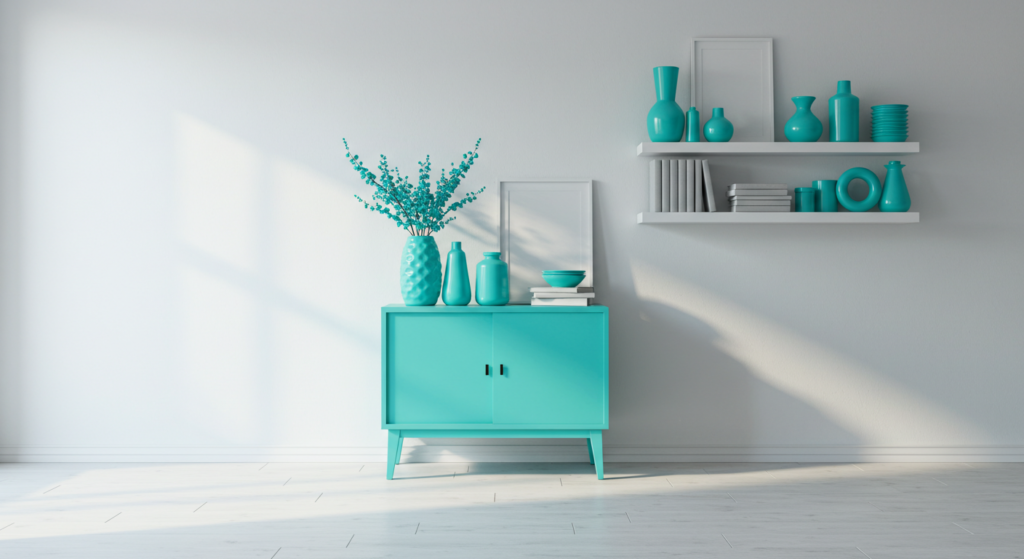
Color becomes a tool for storytelling. Each shade can bring a different vibe to your space. You do not have to follow a “traditional” color scheme. Instead, think about what complements your home decor.
Evaluating Existing Elements
Before deciding on a color, note what you already have. Do you have wooden floors, white walls, or metal fixtures? These details impact how your accent color will look. For instance, a bright orange throw pillow can energize a charcoal sofa. But it can also clash with a rug of a different hue.
Consider your overall interior design style too. If your home leans modern, crisp and clean colors might look best. If you have a boho vibe, earthy tones or jewel shades can appear more organic.
Testing Color Samples
Paint swatches can look different in varied light. Grab a few sample pots and try them on your wall. Check them at morning, midday, and evening. You might be surprised how a color shifts. Some folks skip this step and end up repainting. Testing first can spare you frustration later.
For smaller accents like pillows or rugs, bring home physical samples. Fabric can appear a shade or two off under your lights. Aim for a color that feels balanced next to your furniture.
Timing Your Changes
When you refresh color, consider your timeframe. If you plan a big party, you might want to pick a shade that feels lively. If you are redecorating during cooler months, deeper tones might fit the season. There is no perfect time to add color, but seasonality can affect mood and lighting conditions.
Contrasting Neutral Tones with Bold Hues

Neutral colors remain popular in home decor for a reason. They serve as a calm backdrop. Bold hues add excitement. Together, they can create a polished, harmonious design.
Why Neutral Tones Matter
Neutrals provide breathing room for bright accents. White, beige, gray, or even soft taupe calm a room, letting statement pieces shine. If your walls are mostly neutral, a single bright color can stand out and become a focal anchor. Neutral backdrops allow the eye to rest before it lands on your accent.
Incorporating Pops of Color
The simplest way to inject bold color is through accessories. You can add bright throw pillows, an area rug with splashes of color, or even a tall vase in a vivid shade. This approach is flexible. You can swap items out if you get bored or if you like to update your decor every season.
- Pillows and throws: Choose contrasting colors that pull out small hints in the rest of the decor.
- Decorative objects: Consider fun sculptures or statement lamps in a single striking color.
- Curtains: A bold set of drapes can catch the eye and turn a window into a focal highlight.
Finding Balance
Balance is key. If you have a neutral sofa and add bright pink pillows, keep the rest of the palette subtle. A single pink accent in one corner can look out of place. Instead, repeat small hints of that same color on another item, like a picture frame or a small ottoman. This trick ties the look together.
Using Patterns and Prints for Impact

Color is not limited to solid blocks of paint. Patterns or prints can add depth and complexity. They also provide an unexpected focal effect. A patterned item stands out because it breaks uniformity.
Mixing Prints Wisely
Clashing prints can make a space feel busy. If you want to experiment with patterns, look for a unifying factor. Maybe each print has the same base color. Or perhaps they share a common shape. A rug with geometric shapes might pair well with throw pillows that have smaller, subtle geometric lines. The eye sees the connection and reads it as consistent.
Large-Scale vs. Small-Scale Patterns
Large-scale patterns (like wide stripes or oversized florals) can create dramatic focal points. These prints can ground an entire room and become the star. Smaller patterns, like delicate polka dots or miniature motifs, add hints of interest but do not dominate the space. If you want your pattern to be the focal star, lean into bigger designs.
Layering Patterns in Different Rooms
Each room can handle patterns differently. A bedroom can pull off bold prints on the headboard wall or bedding, while the living room might showcase patterned cushions instead. Avoid overloading patterns in every corner. Keep one or two patterned features as the main attraction.
Accent Walls and Their Impact

An accent wall remains a popular way to bring color into a room. It draws the eye fast and can transform a plain space into a curated setting. Done correctly, an accent wall can frame your favorite piece of furniture or a cherished artwork.
Choosing the Right Wall
Look for a wall that already feels prominent. Often it faces the entrance to the room. You could also choose a wall that sits behind a striking piece of furniture, like a tufted sofa or a vintage console table. The accent color will highlight the item in front of it.
Selecting the Best Paint Finish
Paint has a wide range of finishes, from matte to high-gloss. Each reflects light differently. A matte finish softens bold shades. A satin or semi-gloss paint can bounce more light, making darker tones appear slightly brighter. If you want an accent wall that whispers instead of shouts, pick a less reflective finish. If you want a striking statement, go glossier.
Decor Add-Ons for Accent Walls
Once your wall is painted, think about what you place on or near it.
- Large artwork: Frames with metallic details can catch extra light.
- Sconces or wall lights: These fixtures add visual drama and emphasize color.
- Shelving: Open shelves can create dimension and showcase curated decor items against the accent color.
Statement Furniture as a Focal Point
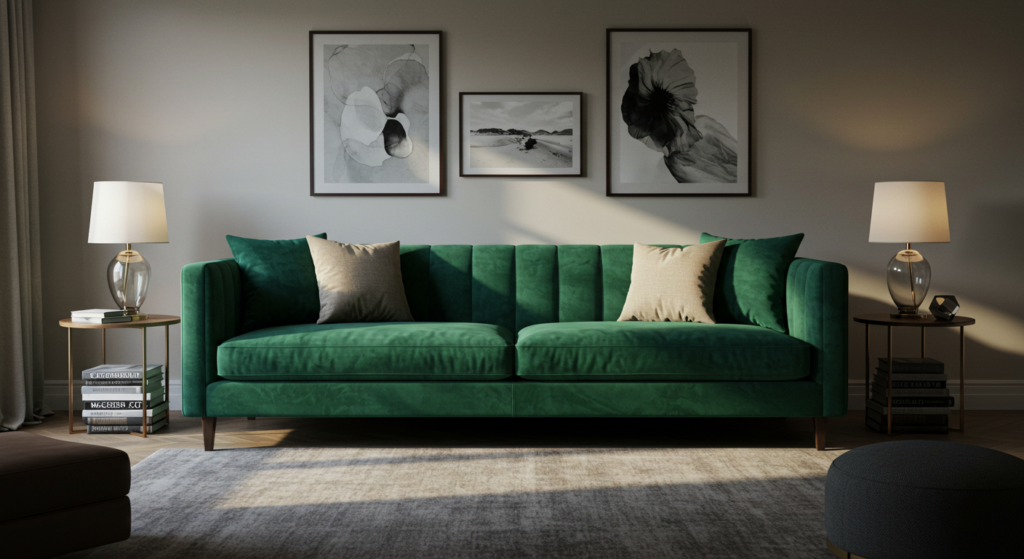
Not every focal point involves paint. A statement piece of furniture can anchor a room and create a purposeful color pop. This is ideal if you are hesitant to change your walls but still want a bolder look.
Picking Furniture That Pops
Look for silhouettes or hues that command attention. A velvet sofa in a vivid shade of cobalt or emerald can become a showstopper in a neutral living room. In the bedroom, a tufted headboard in a striking color can add flair. Keep other furniture items more understated so the statement piece stands out.
Coordinating with Existing Decor
A bright piece of furniture should not clash with everything else. If your main accent chair is red, then let hints of that color appear across the room. You could have a small piece of artwork with red accents or a set of red-trimmed coasters on the coffee table. These small echoes of color keep the room looking cohesive.
Maintenance and Care
Statement furniture tends to see a lot of use. If you pick a pale-colored sofa or chair, take extra care with stains. A protective fabric spray can help. For deeper shades, vacuum or brush them regularly to avoid dust buildup. This keeps the color looking fresh and maintains the focal effect.
Decor Accessories That Pop

Sometimes you can craft a focal point with smaller objects. This works especially well if you want to switch decor styles often or if you rent and cannot paint walls. Strategic accessories can draw the eye and bring excitement to any space.
Curated Display Shelves
Arranging small items on open shelving can form a single point of focus. For instance, you can cluster three or four decorative vases in bright colors. Place them at eye level. These vases catch attention as a set, rather than as random scattered objects.
Layered Textiles
Rugs, throw blankets, and pillows can layer color in surprising ways. In a bedroom, fold a bold throw at the foot of the bed, and top it with a smaller patterned blanket. If your floor is neutral, a rug in a complementary shade anchors the arrangement. Vary texture as well. Mixing different fabrics adds richness.
Unexpected Decor Finds
Do not skip the power of quirky items. A bright ceramic statue or a large handmade basket might stand out. Keep an eye out for unique pieces at home decor stores or online. Use them to direct focus toward a spot in the room that you wish to highlight, like a bare corner or a plain console table.
Lighting to Enhance Color Focal Points

Light can be the difference between a color that looks dull and one that glows. When you plan a focal point, good lighting seals the deal. It also makes everyday activities in that space more enjoyable.
Understanding Natural vs. Artificial Light
Natural light changes throughout the day. If your focal point sits near a large window, watch how the color looks under sunny skies versus cloudy weather. Artificial lighting, on the other hand, allows you to control brightness. You can install spotlights or directional lamps that wash the focal point with an even glow.
Types of Lighting Fixtures
- Track lighting: Great for highlighting wall art or accent walls. You can angle each track head as needed.
- Floor lamps: They can direct light up or down onto a statement piece of furniture.
- Table lamps: Perfect for smaller accessories or focal areas on side tables.
- Wall sconces: Create stylish uplights or downlights.
Mood and Ambiance
Bright overhead lighting can be harsh on bold colors. Consider using dimmers or smart bulbs. They let you adjust the intensity of your focal lighting. Warm-toned bulbs can add coziness. Cooler-toned bulbs keep colors crisp. Pick a bulb color temperature that flatters your chosen accent shade. Also, keep lighting consistent across the room so your focal point does not look out of place.
Playing with Textures and Materials

Color alone can highlight a focal point, but combining it with texture levels up the effect. Textured elements add interest even if they share the same shade as surrounding items.
Texture on Walls
You can create accent walls using textured wallpaper, wood paneling, or brick veneers. These surfaces catch light differently. A gray wood panel might appear deeper in tone compared to flat gray paint. If you prefer minimal color but still want a focal point, texture becomes a powerful substitute.
Mixed-Material Furniture
Furniture that blends materials will stand out. Think of a wooden coffee table with metal inlays, or a velvet stool with a brass base. Even if the color is subtle, the mixture of fabrics or finishes draws attention. You can spotlight these pieces with a small accent lamp or a pendant light hanging above.
Coordinating Textures in Decor
Texture can exist in smaller accessories too. Layer a chunky knit throw over a sleek leather chair. Place a rough-hewn wooden bowl on a polished marble countertop. These pairings catch the eye. They do not need loud colors to shine. However, if you want to push it further, introduce a bold color into one of these textural pieces.
Coordinating Rooms and Open Spaces

Open-concept areas often blend living, dining, and kitchen spaces. This can make it tricky to create a single focal point. Instead, you might have multiple smaller focal points that flow together. The key is color coordination.
Defining Zones
Paint each zone in a complementary palette. You do not need each area to be the exact same shade. Instead, choose colors that harmonize. The focal point in the living area might be a large accent wall, while the dining spot features a bold rug under the table.
Creating Visual Pathways
Your eye should move easily from one zone to the next. You can do this by repeating colors or patterns. If your living area has a teal accent wall, include teal cushions in the dining area. This small repetition ties the areas together and prevents an abrupt visual break.
Balancing Large Spaces
A big open layout can overpower a single focal point if it is too small. Consider bigger statements: a full-length bookcase in a bright hue or a floor-to-ceiling piece of artwork. These large additions ensure your focal point remains noticeable in an expansive environment.
Seasonal Color Updates
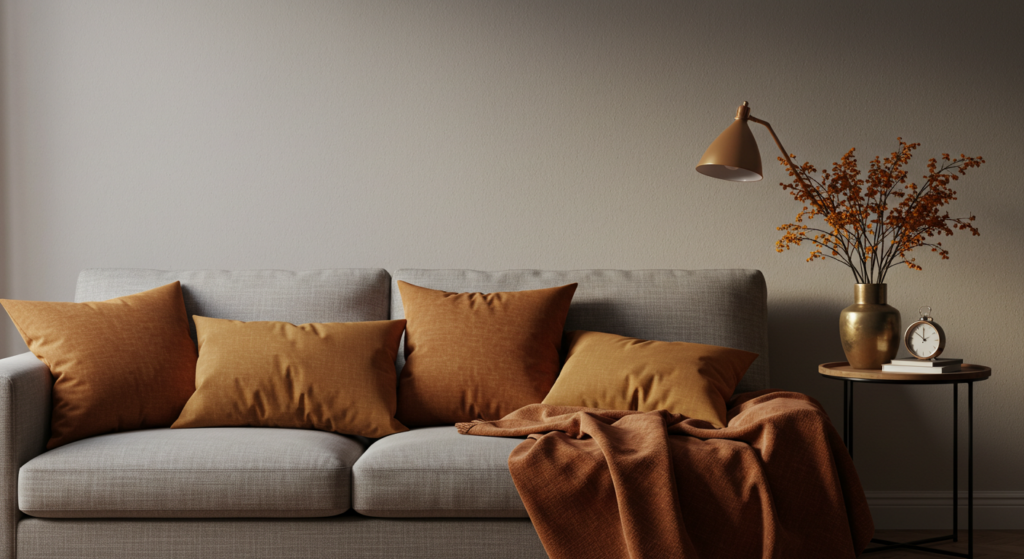
You do not need permanent color changes to refresh a focal point. Updating with the seasons can keep your decor exciting. This approach works if you love trying new shades but do not want the commitment of repainting walls every few months.
Swapping Soft Furnishings
Throw pillows, blankets, and curtains are simple to switch out. In cooler months, cozy textures and warmer tones feel inviting. As it gets warmer outside, you can shift to lighter fabrics and cooler colors. Storing the out-of-season items in labeled bins helps you rotate them smoothly.
Changing Decor Accents
A focal point can evolve with subtle changes to nearby accents. A mantel, for instance, can hold winter-themed decor in colder months and switch to bright floral arrangements in spring. By matching these additions to a chosen color palette, you keep the focal area fresh.
Adding Removable Wallpaper
Modern peel-and-stick wallpapers offer a quick way to add or remove bold patterns and colors. You can use them on a single wall or to line the back of a bookshelf. They peel off without damaging surfaces, making them ideal for rentals or seasonal updates.
Clever Color Tricks for Small Rooms

Small rooms can benefit from color illusions. With the right choices, you can make a space appear bigger or cozier, depending on your goals.
Light Colors That Expand
Pale shades reflect more light. Soft whites, light grays, and subdued pastels can help a room feel open. If you want a focal point, paint one wall in a slightly darker tone. This small contrast keeps the overall space airy but adds a hint of depth.
Vertical Emphasis
Painting vertical stripes can make low ceilings seem taller. You can also install floor-length curtains close to the ceiling to draw the eye upward. For a focal wall, choose a pattern that highlights vertical lines. It gives the illusion of more height and drama.
Multi-Purpose Furniture
In a small room, the focal point might be a daybed or a desk. Pick a color that sets this piece apart. A built-in cabinet or a shelving unit in a bold color can serve as a functional storage area and a visual highlight. Tie in smaller items (like drawer knobs or frames) in the same color to reinforce the theme.
Large Spaces and Bold Statements

Spacious rooms can sometimes lack warmth. Filling them up with furniture helps, but color also matters. Big spaces can handle more dramatic color moves because they will not feel too overwhelming.
Oversized Wall Art
Go big with a massive painting or tapestry in bold, rich shades. One large piece can anchor the whole room. Position it on a wall that faces the main entry point. Ensure you have adequate lighting so it does not fade into the background.
Color Blocking
In an open, airy room, you can experiment with color blocking. Paint one section of a wall in a contrasting color. Use a tall divider or a bookshelf painted in a vivid hue to mark different zones. Even simple color block curtains can separate living, dining, or lounge areas without building actual walls.
Multiple Focal Points
A large space can sometimes support more than one focal zone. You might have a colorful accent wall on one side and a statement fireplace on another. The key is to connect them somehow. You might repeat a similar color, shape, or texture, so they do not compete but coexist.
Maintaining and Refreshing Your Focal Point Over Time

A stunning focal point can lose impact if it becomes worn out or falls behind current trends. Regular upkeep keeps your space looking fresh. It also lets you experiment without a full redesign.
Dusting and Cleaning
Bright surfaces show dust more easily. For painted walls, gently wipe them with a damp cloth if you see marks. For bold furniture or rugs, vacuum them every week or two. Follow manufacturer instructions for any deeper cleaning.
Minor Touch-Ups
Painted surfaces can chip. Keep a small can of your accent color on hand for quick fixes. For furniture, use fabric cleaners or spot treatment as soon as you notice a stain. If you went for patterned wallpaper, check seams over time and re-adhere any loose edges. This small maintenance routine preserves your focal point’s charm.
Updating Accessories
You can swap out small elements to refresh the look. Maybe you keep your teal accent wall but change throw pillows to a different color each year. Maybe you keep your statement sofa but replace side tables or lamps in new finishes. These subtle changes can make the focal spot feel current without a major overhaul.
Conclusion
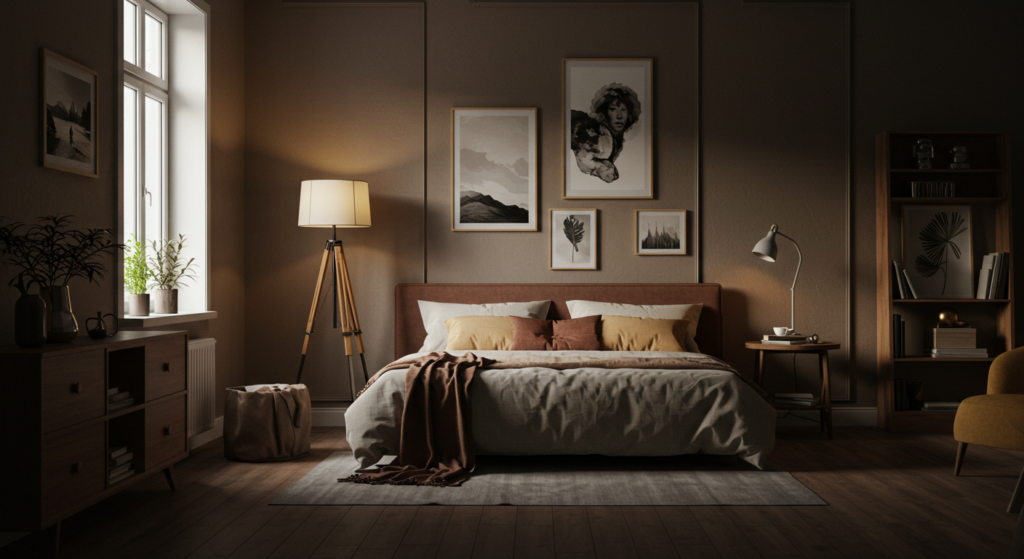
A well-chosen focal point breathes life into a room. By using color in smart ways, you guide the eye to that special feature and create an atmosphere that feels thoughtfully designed.
Whether you opt for a bold accent wall or a vibrant piece of furniture, color can set the stage for your entire space.
Consider how texture, lighting, and smaller accessories can join forces with your chosen hue. This synergy matters. It tells a visual story.
Each room becomes a mini-exhibit that shows off your taste. And it does so without requiring too much effort or expense. With a bit of know-how and a willingness to play with color, you can shape a home you are proud to share.
Summary Table
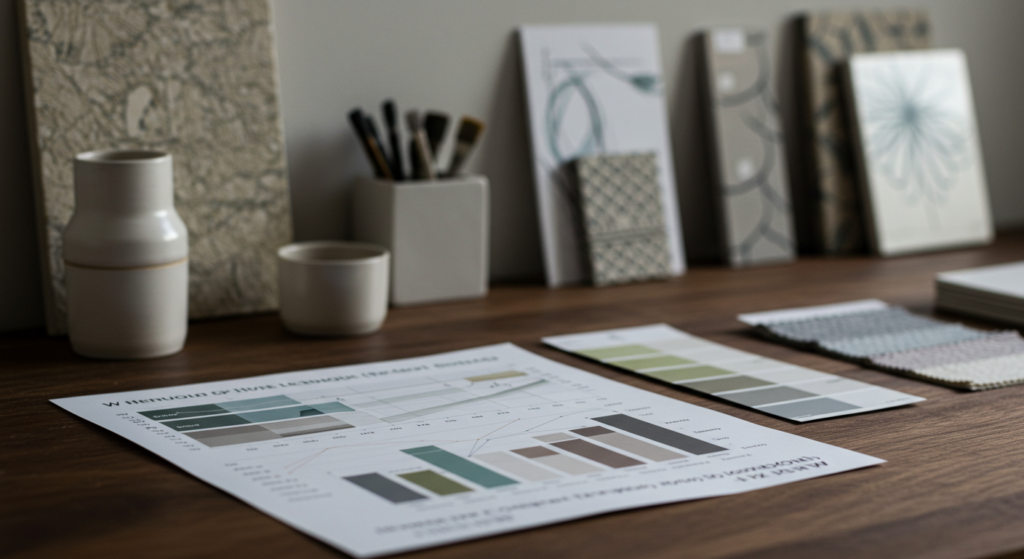
Below is a quick overview of focal point ideas and color techniques to help you find the right approach for your space.
| Strategy | Where It Works | Key Tips |
|---|---|---|
| Accent Wall | Living rooms, bedrooms, dining rooms | Pick a prominent wall, test paint finishes, add lighting or art |
| Statement Furniture | Large or small spaces, flexible style | Choose a strong color, keep other furniture neutral, add matching accents |
| Bold Accessories | Rentals, budget-friendly updates | Use throw pillows, vases, rugs, and lamps to create a color pop |
| Textured Surfaces | Feature walls, floors, accent furniture | Mix materials for depth, stay consistent with the room’s overall style |
| Patterns and Prints | Any room needing visual interest | Keep a unifying color or theme, balance large and small-scale prints |
| Seasonal Switches | All rooms, especially living spaces | Swap curtains, pillows, and removable wallpaper for fresh color updates |
| Open-Plan Coordination | Homes with combined living/dining | Define zones with matching or complementary shades, repeat accent color |
| Lighting Enhancements | Areas needing extra brightness | Spotlight the focal point with dimmers, track lighting, or sconces |
FAQ

1. Can I have more than one focal point in a single room?
Yes. Large spaces can handle multiple highlights. Use related colors or shapes for each focal area so they do not clash.
2. What if my furniture is neutral? How do I add color without painting walls?
Use bright textiles, artwork, and decor objects. A colorful area rug or set of throw pillows can act as a focal accent. You can also experiment with peel-and-stick wallpaper on a small wall or in an alcove.
3. Should my focal color match other items in the room?
Matching some accents can help maintain a cohesive look. For instance, if your accent wall is teal, you might add teal trim on pillows or a teal vase.
4. Will a dark color make my room feel smaller?
Sometimes, yes. But in many cases, a single dark wall can add depth and contrast, which makes the room look more interesting rather than just small.
5. How often should I update my focal point?
Whenever you feel the urge for a change. Some people switch accents each season. Others keep theirs for years. The important part is to maintain it—fix chips in paint, clean fabrics, and dust surfaces.
6. Where can I find unique decor items for a bold accent?
Online marketplaces, artisan shops, or local craft fairs can be great sources. Search for handmade pieces that catch attention. Statement pieces from these places often feel special and one-of-a-kind.
7. What if I want a cohesive look throughout my entire home?
Pick a color palette and pull hints of it into each room. You could have variations of a single color or complementary shades. Keep at least one or two unifying elements in all rooms so everything feels connected.
8. Does the finish of paint really matter that much?
Yes. Different sheens catch the light in unique ways. A high-gloss finish makes colors appear bolder. A matte or flat finish can soften them. Always test finishes before finalizing.
9. How do I choose a focal point when my room is small and lacks architectural features?
Create your own. A large piece of art, a bold piece of furniture, or even a bookshelf painted in a standout color can serve as a focal point.
10. Should I worry about trends?
It depends. If you love a trend, go for it. But do not chase a style if it does not feel like you. Classic choices often stand the test of time, while trendy shades can be swapped out easily in accessories.
11. Can I use metallics as a focal color?
Yes, metallic finishes like gold, brass, or silver can be eye-catching. Use them on lamps, mirrors, or small accent furniture. Just be cautious about mixing too many different metals in one space.
12. What if I prefer minimalistic design?
A subtle color accent can still be a focal point. You do not have to go bold. Even a gentle shift from a white wall to a soft gray accent can provide enough contrast in a minimalist setup.
13. How do I prevent my focal point from feeling overwhelming?
Stick to one main spot for bold color. Let the rest of the room act as a neutral canvas. Also, choose a color you genuinely like to look at every day.
14. Can lighting alone create a focal point without adding color?
Yes, light can highlight certain areas or objects and make them stand out. However, pairing color with the light effect can produce a deeper sense of focus.
By following these tips, you can use color to craft a strong, clear focal point in any room. Enjoy exploring new shades and fresh ideas as you transform your home decor!

Anna West, the visionary behind Clothes Color Guide, is our go-to for all things fashion. Merging the finest of runway trends with everyday style, she demystifies the world of color and pattern. While clothing is her mainstay, Anna also shares insights on interior design, pet care, and relationship advice. Dive into her articles and emerge with a vibrant perspective on style and life.
Reviewed By: Joanna Perez and Marcella Raskin
Edited By: Lenny Terra
Fact Checked By: Sam Goldman
Photos Taken or Curated By: Matthew Mansour
